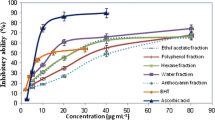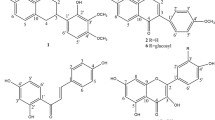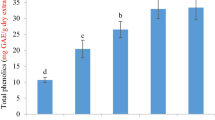Abstract
Satureja kitaibelii Wierzb. ex Heuff. has a great importance in Serbian ethnopharmacology/herbal traditional medicine, as well as a flavoring food additive. Ethanol extract of aerial parts of Satureja kitaibelii analyzed by liquid chromatography-mass spectrometry revealed the presence of 18 compounds among which the most abundant were phenolic acids, flavonoids, jasmonic acid derivatives and rosmanol. The extracts were rich in total phenolics and flavonoid contents, while rosmarinic acid was the dominant compound (18.30–29.52 mg/g). As assessments of antioxidant properties of natural extracts are important because of their growing use in medicine and food industry, antioxidant activity of ethanol extracts of Satureja kitaibelii was analyzed by several assays. The half maximal scavenging capacity (SC50) of 2,2′-diphenyl-1-picrylhydrazyl ranging from 71.20 to 125.65 μg/mL, the total antioxidant capacity from 272.37 to 714.12 mg ascorbic acid/g, and ferric ion reducing antioxidant power ranging from 0.74 to 1.94 μmol Fe/mg, clearly imply a significant antioxidant potential of Satureja kitaibelii. The extracts inhibit growth of Micrococcus luteus and Pseudomonas aeruginosa with inhibition zones 20–30 and 16–26 mm, respectively. Antioxidant and antibacterial activity of compounds identified in extracts suggest a great potential for Satureja kitaibelii application as valuable food ingredient.
Similar content being viewed by others
Abbreviations
- DPPH:
-
2,2-diphenyl-1-picrylhydrazyl
- TPTZ:
-
2,4,6-tris(2-pyridyl)-s-triazine
- LC-MS:
-
Liquid chromatography – mass spectrometry
- RA:
-
Rosmarinic acid
- ESI:
-
Electron spray ionization
- PDA:
-
Photo diode array detector
- UV:
-
Ultra violet
- Rt :
-
Retention time
- TPC:
-
Total phenolic content
- TFC:
-
Total flavonoid content
- TAC:
-
Total antioxidant capacity
- GA:
-
Gallic acid
- AA:
-
Ascorbic acid
- FRAP:
-
Ferric ion reducing antioxidant power
References
Reische DW, Lillard DA, Eitenmiller RR (1998) Antioxidants in food lipids. In: Ahoh CC, Min DB (eds) Chemistry, nutrition and biotechnology. Marcel Dekker, New York, pp 423–448
Brunetti C, Di Ferdinando M, Fini A, Pollastri S, Tattini M (2013) Flavonoids as antioxidants and developmental regulators: relative significance in plants and humans. Int J Mol Sci 14:3540–3555
Pistelli L, Giorgi I (2012) Antimicrobial properties of flavonoids. In: Patra AK (ed) Dietary phytochemicals and microbes. Springer Science+ Business Media, Dordrecht, pp 33–91
Batra P, Sharma AK (2013) Anti-cancer potential of flavonoids: recent trends and future perspectives. 3 Biotech 3(6):439–459. https://doi.org/10.1007/s13205-013-0117-5
López-Cobo A, Gómez-Caravaca AM, Švarc-Gajić J, Segura-Carretero A, Fernández-Gutiérrez A (2015) Determination of phenolic compounds and antioxidant activity of a Mediterranean plant: the case of Satureja montana subsp. kitaibelii. J Funct Foods 18:1167–1178
Dróżdż P, Šėžienė V, Pyrzynska K (2017) Phytochemical properties and antioxidant activities of extracts from wild blueberries and lingonberries. Plant Foods Hum Nutr 72:360–364
Ball PW (1974) Genus Satureja L. In: Tutin TG, Heywood VH, Burges NA, Moore DM, Valentine DH, Walters SM (eds) Flora Europaea 3. Cambridge University Press, Cambridge
Zlatković B, Bogosavljev S, Radivojević A, Pavlović M (2014) Traditional use of the native medicinal plant resource of Mt. Rtanj (Eastern Serbia): ethnobotanical evaluation and comparison. J Ethnopharmacol 151:704–713
Momtaz S, Abdollahi M (2010) An update on pharmacology of Satureja species; from antioxidant, antimicrobial, antidiabetes and anti-hyperlipidemic to reproductive stimulation. Int J Pharmacol 6(4):346–353
Tepe B, Cilkiz M (2016) A pharmacological and phytochemical overview on Satureja. Pharm Biol 54(3):375–412
Kundaković T, Milenković M, Zlatković S, Kovačević N, Nikolić G (2011) Composition of Satureja kitaibelii essential oil and its antimicrobial activity. Nat Prod Commun 6:1353–1356
Stanojković T, Kolundžija B, Ćirić A, Soković M, Nikolić D, Kundaković T (2013) Cytotoxicity and antimicrobial activity of Satureja kitaibelii Wierzb. Ex Heuff (Lamiaceae). Dig J Nanomat Bios 8(2):845–854
Ćetković GS, Čanadanović JM, Djilas SM, Tumbas VT, Markov SL, Cvetković DD (2007) Antioxidant potential, lipid peroxidation inhibition and antimicrobial activities of Satureja montana L. subsp. kitaibelii extracts. Int J Mol Sci 8(10):1013–1027
Singleton VL, Rossi JA (1965) Colorimetry of total phenolics with phosphomolybdic-phosphotungstic acid reagents. Am J Enol Vitic 16:144–158
Prieto P, Pineda M, Aguilar M (1999) Spectrophotometric quantitation of antioxidant capacity through the formation of a phosphomolybdenum complex: specific application to the determination of vitamin E. Anal Biochem 269:337–341
Takao T, Kitatani F, Watanabe N, Yagi A, Sakata A (1994) Simple screening method for antioxidants and isolation of several antioxidants produced by marine Bacteria from fish and shellfish. Biosci Biotechnol Biochem 58(10):1780–1783
Szőllősi R, Szőllősi Varga I (2002) Total antioxidant power in some species of Labiatae (adaptation of FRAP method). Acta Biologica Szegediensis 46(3–4):125–127
Acar JF, Goldstein FW (1996) Disc susceptibility test. In: Lorian V (ed) Antibiotics in laboratory medicine. Williams and Wilkins, Baltimore, pp 1–52
Moghadam SE, Samad N, Ebrahimi SN et al (2015) Metabolite profiling for caffeic acid oligomers in Satureja biflora. Ind Crop Prod 76(15):892–899
Pacifico S, Galasso S, Piccolella S, Kretschmer N, Pan SP, Marciano S, Bauer R, Monaco P (2015) Seasonal variation in phenolic composition and antioxidant and anti-inflammatory activities of Calamintha nepeta (L.) Savi. Food Res Int 69(1):121–132
Galasso S, Pacifico S, Kretschmer N, Pan SP, Marciano S, Piccolella S, Monaco P, Bauer R (2014) Influence of seasonal variation on Thymus longicaulis C. Presl. Chemical composition and its antioxidant and anti-inflammatory properties. Phytochemistry 107:80–90
Damašius J, Venskutonis PR, Kaškonienėb V, Maruška A (2014) Fast screening of the main phenolic acids with antioxidant properties in common spices using on-line HPLC/UV/DPPH radical scavenging assay. Anal Methods-UK 6:2774–2779
Tsimogiannis D, Choulitoudi E, Bimpilas A, Mitropoulou G, Kourkoutas Z, Oreopoulou V (2017) Exploitation of the biological potential of Satureja thymbra essential oil and distillation by-products. J Appl Res Med Aromat Plants 4:12–20
Hajdari A, Mustafa B, Kaçiku A et al (2016) Chemical composition of the essential oil, total phenolics, total flavonoids and antioxidant activity of methanolic extracts of Satureja Montana L. Rec Nat Prod 10(6):750–760
Zeljković Ćavar S, Topčagić A, Požgan F, Štefane B, Tarkowski P, Maksimović M (2015) Antioxidant activity of natural and modified phenolic extracts from Satureja montana L. Ind Crop Prod 76:1094–1099
Serrano C, Matos O, Teixeira B, Ramos C, Neng N, Nogueira J, Nunes ML, Marques A (2011) Antioxidant and antimicrobial activity of Satureja montana L. extracts. J Sci Food Agric 91:1554–1560
Sacchetti G, Maietti S, Muzzoli M, Scaglianti M, Manfredini S, Radice M, Bruni R (2005) Comparative evaluation of 11 essential oils of different origin as functional antioxidants, antiradicals and antimicrobials in food. Food Chem 91:621–632
Choirunnisa A, Fidrianny I, Ruslan K (2016) Comparison of five antioxidant assays for antioxidant capacity from three Solanum sp. extracts. Asian J Pharm Clin Res 9(Suppl 2):123–128. https://doi.org/10.22159/ajpcr.2016.v9s2.13155
Arteaga J, Ruiz-Montoya M, Palma A, Alonso-Garrido G, Pintado S, Rodríguez-Mellado J (2012) Comparison of the simple cyclic voltammetry (CV) and DPPH assays for the determination of antioxidant capacity of active principles. Molecules 17:5126–5138
Firuzi O, Lacanna A, Petrucci R, Marrosu G, Saso L (2005) Evaluation of the antioxidant activity of flavonoids by ferric reducing antioxidant powerQ assay and cyclic voltammetry. Biochim Biophys Acta 1721:174–184
Acknowledgements
This work was supported by the Ministry of Education, Science and Technological Development of the Republic of Serbia (Grants No.175056, 173029, ON 173021 and III43004).
Author information
Authors and Affiliations
Corresponding author
Ethics declarations
Conflict of Interest
The authors declare no conflict of interest.
Human and Animal Studies
This article does not contain any studies with human or animal subjects.
Additional information
Publisher’s Note
Springer Nature remains neutral with regard to jurisdictional claims in published maps and institutional affiliations.
Electronic supplementary material
ESM 1
(PDF 73 kb)
Rights and permissions
About this article
Cite this article
Gopčević, K., Grujić, S., Arsenijević, J. et al. Phytochemical Properties of Satureja kitaibelii, Potential Natural Antioxidants: a New Insight. Plant Foods Hum Nutr 74, 179–184 (2019). https://doi.org/10.1007/s11130-019-0716-3
Published:
Issue Date:
DOI: https://doi.org/10.1007/s11130-019-0716-3




